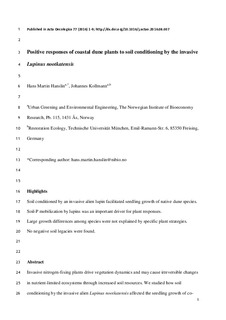| dc.contributor.author | Hanslin, Hans Martin | |
| dc.contributor.author | Kollmann, Johannes | |
| dc.date.accessioned | 2017-11-27T21:42:49Z | |
| dc.date.available | 2017-11-27T21:42:49Z | |
| dc.date.created | 2016-10-20T11:25:02Z | |
| dc.date.issued | 2016-08-26 | |
| dc.identifier.citation | Acta Oecologica. 2016, 77 1-9. | nb_NO |
| dc.identifier.issn | 1146-609X | |
| dc.identifier.uri | http://hdl.handle.net/11250/2468181 | |
| dc.description.abstract | Invasive nitrogen-fixing plants drive vegetation dynamics and may cause irreversible changes in nutrient-limited ecosystems through increased soil resources. We studied how soil conditioning by the invasive alien Lupinus nootkatensis affected the seedling growth of co-occurring native plant species in coastal dunes, and whether responses to lupin-conditioned soil could be explained by fertilisation effects interacting with specific ecological strategies of the native dune species. Seedling performance of dune species was compared in a greenhouse experiment using field-collected soil from within or outside coastal lupin stands. In associated experiments, we quantified the response to nutrient supply of each species and tested how addition of specific nutrients affected growth of the native grass Festuca arundinacea in control and lupin-conditioned soil. We found that lupin-conditioned soil increased seedling biomass in 30 out of 32 native species; the conditioned soil also had a positive effect on seedling biomass of the invasive lupin itself. Increased phosphorus mobilisation by lupins was the major factor driving these positive seedling responses, based both on growth responses to addition of specific elements and analyses of plant available soil nutrients. There were large differences in growth responses to lupin-conditioned soil among species, but they were unrelated to selected autecological indicators or plant strategies. We conclude that Lupinus nootkatensis removes the phosphorus limitation for growth of native plants in coastal dunes, and that it increases cycling of other nutrients, promoting the growth of its own seedlings and a wide range of dune species. Finally, our study indicates that there are no negative soil legacies that prevent re-establishment of native plant species after removal of lupins. | nb_NO |
| dc.language.iso | eng | nb_NO |
| dc.publisher | Elsevier | nb_NO |
| dc.relation.uri | http://dx.doi.org/10.1016/j.actao.2016.08.007 | |
| dc.rights | Attribution-NonCommercial-NoDerivatives 4.0 Internasjonal | * |
| dc.rights.uri | http://creativecommons.org/licenses/by-nc-nd/4.0/deed.no | * |
| dc.subject | dune restoration | nb_NO |
| dc.subject | invasive legume | nb_NO |
| dc.subject | lupin | nb_NO |
| dc.subject | nitrogen fixation | nb_NO |
| dc.subject | phosphorus mobilization | nb_NO |
| dc.subject | soil legacy | nb_NO |
| dc.title | Positive responses of coastal dune plants to soil conditioning by the invasive Lupinus nootkatensis | nb_NO |
| dc.type | Journal article | nb_NO |
| dc.type | Peer reviewed | nb_NO |
| dc.description.version | acceptedVersion | nb_NO |
| dc.rights.holder | © 2016 Elsevier Masson SAS. All rights reserved | nb_NO |
| dc.source.pagenumber | 1-9 | nb_NO |
| dc.source.volume | 77 | nb_NO |
| dc.source.journal | Acta Oecologica | nb_NO |
| dc.identifier.doi | 10.1016/j.actao.2016.08.007 | |
| dc.identifier.cristin | 1393167 | |
| dc.relation.project | Norges forskningsråd: 213291 | nb_NO |
| cristin.ispublished | true | |
| cristin.fulltext | postprint | |
| cristin.qualitycode | 1 | |

